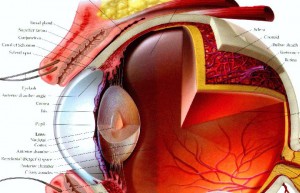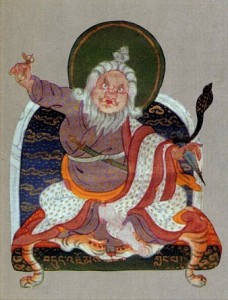
The following is respectfully quoted from “Buddhahood Without Meditation” by Dudjom Lingpa:
First, to reach a definitive conclusion (tan la wab-pa) regarding view, the sacred key point is to come to a definitive understanding through four topics — ineffability (med-pa), oneness (chig-pu), openness (khyal-wa), and spontaneous presence (lhun-drub) — and realize these just as they are.
In the first of these topics, the process of reaching a definitive conclusion regarding ineffability has two divisions: coming to a definitive conclusion about personal identity (gang zag gi dag) and a definitive conclusion about the identity of phenomena (chho kyi dag).
Let us begin by defining “personal identity.” The impression that an identity (dag) exists, whether in waking experience, dream states, the bardo–the intermediate state of conditioned existence between death and rebirth–or the next lifetime, is termed “personal identity.” Immediately following this first impression, there is an underlying consciousness that takes this impression to be an “I” and that is termed “subsequent consciousness” or “conceptualization.” As attention is given to this, it comes to seem stable and solid. For these reasons, by trying to locate the source from which this so-called I first occurs, you will arrive at the conclusion that it has no authentic source.
In searching for a place where this identity might dwell between its origination and its cessation, you should examine in the following way to determine whether, for this so-called I, a location and something located there exist as anything that can be individually identified and characterized.
The head is called “head”; it is not called I. Similarly, the skin of the head is called “skin”; it is not I. Likewise the eyes, in being only eyes, are not I. The ears, in being only ears, are not I. The nose, in being only the nose, is not I. The tongue, in being only the tongue, is not I. The teeth, in being only the teeth, are not I. The brains are also not I. As for the muscles, blood, lymph, nerves. blood vessels, and tendons, in being referred to only by their own names, they are not labeled “I.” From this you will gain understanding.
Furthermore, the arms, in being only arms, are not I. The shoulders are likewise not I, nor are the upper arms, the forearms, or the fingers. Moreover, the spine, in being only the spine, is not I. The ribs are not I, the chest is not I, the liver and spleen are not I, the intestines and kidneys are not I, and urine and feces are not I.
As well, this label “I” is not applied to the legs. The label “thighs,” is applied to the thighs. Similarly, the hips are not I. The shins are not I, nor are the insteps of the feet or toes.
To summarize, the outer skin is not labeled “I”; the intermediate layers of muscle and fat, in being referred to as “muscle” and “fat,” are not labeled “I”; the bones within, in being referred to as “bones,” are not labeled “I”; the innermost marrow, in being referred to as “marrow,” is not labeled “I.” Therefore, you can be certain of emptiness in the absence of any location or something located between origination and cessation.
Similarly, you should come to the decision that all final destinations and anything going there are transcended. In actuality, as with impaired vision, there is the appearance that things are what they are not. Moreover, using all these labels is like speaking of the horns of a rabbit.
Second, to reach a definitive conclusion that phenomena lack any identity, you must search for some basis on which labels can be applied, abolish your concepts of the seeming permanence of things, confront the hidden flaws of benefit and harm, and collapse the false cave of hope and fear.
To begin with, if you search for something with ultimate meaning that underlies the application of all names, you will find that this amounts to nothing more than labels being applied to what, in being ineffable, is simply the natural glow (rang-dang) that underlies thought. This is because it is impossible for any phenomenon whatsoever to have ever existed as self-sustaining in terms of being a basis for labeling. For example, what does “head” refer to and why? Is the label applied because the head constitutes the first stage in the growth of the body, because it is round, or because it appears uppermost? In fact, the head is not the first stage in growth of the body, the label “head” is not applied to everything that is round, and when you examine the concepts of “upper” and “lower” there are no absolutes of upper or lower in space. Similarly, the hair of the head is not the head. The skin, in being skin, is not labeled “head.” The bones, in being called “bones,” are not labeled head, and the nose and tongue are not the head.
You might suggest that, if we isolate these parts individually, they do not constitute the head but that their collective mass is called “head.” But if you were to cut off a creature’s head, pulverize it into molecules and subatomic particles, and then show it to anyone in the world, no one would say that it was a “head.” Even if the particles were reconstituted with water, this mass would not be labeled “head.” So you should understand the situation–that there is no object that is the basis for the expression “head,” which is merely a figure of speech.
Let us take a similar case, that of the eyes. The label “eyes” does not apply to spheres that exist in pairs. The sclera is not the eyes. The fluids, nerves, vessels, and blood are likewise not the eyes. If you analyze these components individually, you will see that none of them is the eyes. Nor are the particles of their collective mass or the mass that would be obtained by reconstituting these particles with water. That which sees forms, in being a state of consciousness, is not the eyeballs, as is evidenced by the fact that it causes seeing to take place during dreams and the bardo.
Likewise in the case of the ears, the auditory canals are not the ears. The skin is not the ears. The cartilage, nerves, vessels, blood, lymph, in being referred to by their own names, are not the ears. The powder that would result from pulverizing them would not be the ears. The mass that would be obtained by reconstituting them would not be the ears. If you think that label “ears” applies to that which hears sounds, just observe what hears sounds during dreams, the waking state, and the bardo. It is ordinary mind as timelessly present consciousness, not the ears.
Similarly, all the component parts of the nose–nostrils, skin, cartilage, nerves and blood vessels–in being referred to by their own names, are not labeled “nose.” Since that which smells odors is a state of consciousness, you should examine what smells odors during dreams and the bardo.
In the same way, if you analyze the tongue’s individual components–the muscle, skin, blood, nerves, and vessels–in being referred to by their own names, they are not called “tongue.” The powder that would result from pulverizing them would not be called “tongue.” Even the mass obtained by reconstituting them with water would not be labeled “tongue.”
The same reasoning applies in all of the following cases: In the case of arms, the shoulders are not arms, the upper arms are not arms, nor are the forearms, the fingers and knuckles, the flesh, skin, bones or marrow. Likewise regarding the shoulders, the skin is not the shoulders, nor are the flesh and bones. Neither is the collective mass of molecules or the mass that would be obtained by reconstituting them water. Any basis on which the label “shoulder” could be applied is empty in that it does not exist as an object. When you likewise examine the upper arms and forearms, in being referred to by their respective names–“muscle” for muscle, “bone” for bone, “skin” for skin, and “marrow” for marrow–none of these has ever existed as a basis on which labels could be applied.
By examining the fundamental basis of the expressions “body” and “physical mass,” you can see that the spine and ribs are not called “body.” The heart, lungs, liver, diaphragm, spleen, kidneys, and intestines, in being described by their own names, nevertheless constitute emptiness, in that any basis on which the labels “body” and “physical mass” could be applied is empty since it does not exist as an object.
When you examine the legs in a similar way, you will find that the hips are not the legs, nor are the thighs, shins, or feet. The muscles are not called “hips,” nor are the skin, bones, nerves, vessels, or tendons. Moreover, the skin, muscle, bones, nerves, vessels, or tendons are not called “thighs.” The same is true for shins. Such terms cannot be found to apply to the powder that would result from pulverizing these tissues, nor are they used to refer to the mass that would be obtained by reconstituting the particles with water.
If you search for some basis on which the label “mountain” could be applied in the outer world, you will see that earth is not a mountain, nor are the grasses or trees, the rocks, cliff faces, or water. If you search for some basis on which the labels “building” or “house” could be applied, just as the earth-works are not the house, neither is the stone or the wood. Moreover, as for the walls, in being called “walls,” they are not labeled as “house.” Thus, “house” has never existed anywhere, externally or internally.
You might search for some basis on which such labels as “human being,” “horse,” “dog,” and so forth could be applied. Eyes, ears, nose, tongue, flesh, blood, bones, marrow, nerves, vessels, tendons, and attendant consciousnesses are referred to by their own names, but no object exists as a basis on which the label “human being,” “horse,” or “dog” could be applied.
To take another example, among material objects “drum” does not refer to the wood, the leather, the outside, or the inside. Similarly, “knife” does not refer to the steel. None of the component parts–the blade, the back of the blade, the point, or the haft–has ever existed as an object that could be so labeled. Moreover, names and functions change, as when a knife is used as an awl and its designation changes, or when an awl is used as a needle, and these previous labels all turn out to refer to what have no existence as sense objects.
Relying on what my guru, the noble and sublime Supremely Compassionate One [Avalokiteshvara], said to me in a dream, I came to a thorough realization concerning two points–that which is called “personal identity” and the search for some basis on which labels could be applied.





